Seoul/Jongno - one of the districts (gu) of Seoul, Republic of Korea

Jongno (종로) is in Seoul, and constitutes the northern half of the historic core of Seoul, along with Jung, the southern half. As the soul of Seoul (to coin a phrase), Jongno is home to a plethora of beautiful Joseon Dynasty palaces, shrines, temples, parks, historic neighborhoods, and other traditional sights. Jongno holds four of the five Grand Palaces of Seoul: Gyeongbok-gung, Changdeok-gung,Changgyeong-gung, and Gyeonghui-gung. It also has Jongmyo Shrine, the headquarters of the Korean 'Seon' Buddhist Order Jogyesa Temple, the Bukchon Hanok village, Insadong antiques through-way, the Presidential Palace Cheongwadae, the National Folk Museum of Korea (formerly the National Museum of Korea), and Hyehwa, a district filled with small, independent theaters.
Get in
The main metro stations serving Jongno are Gyeongbukgong (line 3), Anguk (line 3), Jongno-3ga (line 1, 3, 5) and Gwanghwamun (line 5). From Jung, walk along Sejong-daero, a busy road that passes Gwanghwamun Plaza. The plaza has statues and monuments honoring Sejong the Great and Admiral Yi Sun-sin of the Joseon dynasty.
See
- Gwanghwamun Plaza (Gwanghwamun Square, 광화문 광장), 172, Sejong-daero, Jongno-gu, Seoul (Line 5, Gwanghwamun Station; Exit 9 directly leads to the plaza), 37.5748°, 126.9767°. A center of Seoul. The name came from the main gate of the Gyeongbokgung. The site was a location of the Six Ministries during the Joseon dynasty, and was a large motorway since then. In 2009, the middle of the road was opened to public as a renovation project. It's now home to festivals and events. There are two statues in the plaza: Admiral Yi Sun-sin (A legendary admiral who won numerous battles in harsh circumstances), and Sejong the Great (the most famous and popular king in the Korean history, inventor of Korean alphabet). 2018-02-27
Palaces

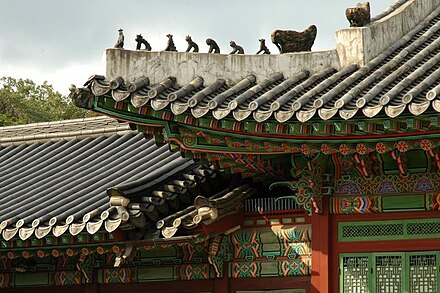
.jpg/440px-Gwanghwamun(%EA%B4%91%ED%99%94%EB%AC%B8).jpg) An Integrated Ticket of Palaces that covers the five Great Palaces of Seoul and Jongmyo Shrine costs ₩10,000 and lasts for 3 months from the time of first entry. All of them have a thicker, more informative pamphlet for ₩500, which is more useful when walking in the palaces. Worth checking out.
An Integrated Ticket of Palaces that covers the five Great Palaces of Seoul and Jongmyo Shrine costs ₩10,000 and lasts for 3 months from the time of first entry. All of them have a thicker, more informative pamphlet for ₩500, which is more useful when walking in the palaces. Worth checking out.
- Gyeongbokgung (경복궁, 景福宮), 161, Sajik-ro, Jongno-gu (Gyeongbokgung(Metro Line 3) or Gwanghwamun stn (Metro Line 5, across the Gwanghwamun plaza)), 37.57735°, 126.97704°, +82 2-3700-3900. 09:00-18:00 (19:00 on holidays), closed Tuesdays. This is Seoul's grandest Joseon Dynasty-era palace and the seat of power for centuries before it was razed in 1592 by a Japanese invasion (and again by the Japanese in 1910). This was the first palace used by the Joseon Dynasty. Large parts have now been restored and the vast grounds also house the Joseon Palace Museum and the Korean Folk Museum. There's a small corner where you get the chance to try on traditional Korean dress for free after registering. Changing of the royal guard at Gwanghwamun (광화문, 光化門), the elegantly restored main gate to the palace, occurs twice a day at 10:00 and 14:00, as soldiers from the South Korean army dressed in Joseon-era uniforms march with traditional weapons to the tune of drumbeats for 20 minutes. ₩3,000 2018-11-01
- Changdeokgung (창덕궁, 昌德宮), 99 Yulgong-ro, Jongno-gu (Metro Line 3, Anguk station 5 min walk or Line 1, 3, 5 Jongno-3ga Station. Mainline bus (blue): 109, 151, 162, 171, 172, 272. Branch line (green): no.7025), 37.579444°, 126.991667°. Tu-Su 09:00-17:00. Second only to Gyeongbokgung in historical importance, it was built in 1405 and was the seat of power between 1618 and 1896. The buildings have been restored to create a dazzling but still elegant effect that got the palace listed as an UNESCO World Heritage Site. The site is better preserved than Gyeongbokgung. Buildings of particular note include the blue-roofed Seonjeongjeon, which was the King's office, and the Daejojeon ("Great Making Hall"), his bedchamber, but perhaps most famous of all is the Huwon ("Secret Garden") in the back. Access to the garden is by guided tour only except on Thursdays when only self-guided tours are available in summer from April to August. English tours are only offered at 10:30 and 14:30, and last around 60 minutes with a walking distance of about 2.5 km, including some steps and inclines for the Huwon portion (the grounds are wheelchair-accessible for most parts but may have to enter certain areas in a reverse direction from the group). Trivia: The building structure is not symmetrical, and has more natural-oriented arrangement than the Gyeongbokgung. You may find some western influences in some buildings which was introduced during the late 1800s, such as a chandelier and the elevated-pathway for the automobile. ₩3,000
- Changgyeonggung (창경궁, 昌慶宮), 37.578431°, 126.995981°. M-Sa 09:00-17:30. It was built in 1104 as a summer palace for the Kings of the Goryeo Dynasty, and became one of the main palaces during the Joseon Dynasty. The palace was used as a temporary home for the King during the time Gyeongbuk Palace was being built. Unlike other palaces that has a North-South orientation, Changgyeong Palace faces East-West. Also, this palace is known for connecting to Jongmyo Shrine, a holy place for the Joseon Dynasty, where sacrificial rites are practiced for previous kings and queens. Sadly, the site was seriously modified during the Japanese-annexation period (1910~1945). The name was changed to Changgyeongwon (literally Changgyeong park), and the site was used as a zoo. Restoration began during the 1980s and the zoo was moved to Gwacheon, which is now Seoul Grand Park. ₩1,000
- Gyeonghui-gung (경희궁,慶熙宮 Seoul History Museum), 37.571087°, 126.968239°. It was built in the 17th century, and was burnt down twice in the 19th century. It was largely destroyed by the Japanese during the colonial rule to build a school for Japanese children. It was finally restored in 1985 and opened to the public. free

- Unhyeongung (운현궁, 雲峴宮), 37.5761°, 126.987°, +82 2-766-9090. A museum in the former palace of a Joseon Dynasty archduke Heungseon, who was father of second last king of the Joseon, it has several mannequins depicting the costumes of the yangban or noble class during the Joseon Dynasty. The palace buildings themselves represent the style of Joseon noble class' mansion well. Free
Shrines and temples
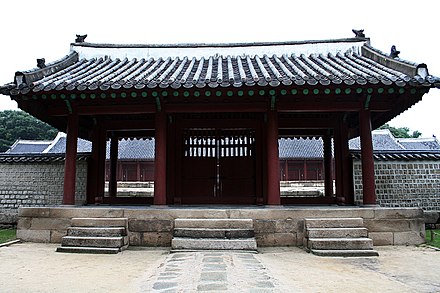
- Jongmyo Shrine (종묘, 宗廟), 157, Jong-ro, Jongno-gu, 37.574722°, 126.993889°, +82 2-765-0195. W-M: Feb-May/Sep-Oct: 09:00-18:00; Jun-Aug: 09:00-18:30; Nov-Jan: 09:00-17:30; closed Tu. The royal ancestral temple during the Joseon Dynasty, this is where the kings would perform sacrificial rituals in honor of their ancestors. Certainly the most famous shrine devoted to the royal family members of Korean dynasties. The grounds are a bit more walker-friendly than some of the palaces, admission is cheaper and they also have some interactive equipment available to learn about the rituals and ceremonies used to treat deceased royal family members. The Jongmyo Shrine is inscribed on the UNESCO World Heritage list. The Jongmyo Jerye (종묘제례) ceremony, which is still led by the head of the former royal family, is held here on the first Sunday of May every year, during which there will be traditional Korean performances as part of the ceremony. English guided tours at 10:00, 12:00, 14:00, 16:00. ₩1,000 2017-11-12
- Jogyesa Temple (조계사, 曹溪寺), 45, Gyeonji-dong, Jongno-gu, 37.5739°, 126.9819°, +82 2-768-8600. The chief temple of the Jogye order of Buddhism, the dominant branch of Buddhism in Korea. As such, it is one of the most important modern Buddhist temples in the country. That being said, Jogyesa Temple is rather small, and if time permits, Bongeun Temple in Gangnam is a larger and more interesting Buddhist temple.
City gates
Seoul has many historic city gates. Two of four great gates can be found in Jongno. (Namdaemun can be found in neighboring Jung)
- Dongdaemun Gate (동대문, 東大門), 69, Jongno6-ga, Jongno-gu, 37.571153°, 127.009639°. More formally known as Heunginjimun (흥인지문, 興仁之門), the old eastern gate of the city still stands. Though not as impressive architecturally as Namdaemun, the Dongdaemun market is infinitely more interesting than the its counterpart.
- Sukjeongmun Gate (숙정문, 肅靖門), San 25-22, Samcheong-dong, Jongno 서울 성북구 성북동 산 25-22, 37.595581°, 126.981156°.
- Changuimun Gate (창의문, 彰義門), Buam-dong, Jongno-gu 서울 종로구 부암동, 37.592614°, 126.966594°.
- National Folk Museum Children's Museum (국립민속박물관 어린이박물관), 37 Samcheong-ro, Jongno-gu, 37.581715°, 126.978985°, +82 2 3704 3014. 9:00
18:00(On Weekday), 9:0019:00(On Weekend). This place provides various experiences and services for children in areas such as exhibition, education, research, and exchange. Free 2022-11-29
Museums
-
Museum Kimchikan (뮤지엄김치간), 4th to 6th floor, 35-4, Insa-dong, Jongno-gu (Subway line 3, Anguk Station, 10 minutes walk along Insadong-gil), 37.57349°, 126.98472°, +82 2-6002-6456. Tu-Su 10:00-18:00. A museum (previously known as Kimchi Field Museum) about all things kimchi. Includes a lot of interactive exhibits and comes with a free audio guide in English. There is also hands-on kimchi making programs, however only on reservation. ₩5,000/3,000 2016-11-18
-
National Museum of Korean Contemporary History (대한민국역사박물관), 198 Sejongdae-ro, Jongno-gu, 37.5738°, 126.977301°. Since the independence from Japan, Korea has experienced a series of political events during short period. You can see exhibitions that show war, dictatorships, uprisings against dictatorships, and industrialization that happened in South Korea. 2017-04-27
-
MMCA Seoul (National Museum of Modern and Contemporary Art, Korea) (국립현대미술관 서울관), 30 Samcheong-ro, Sogyeok-dong, Jongno-gu, Seoul 03062 (14 minute walk from Exit No. 1 from Ankuk Station, Line No. 3. 17 minute walk from Exit No. 2 from Gwanghwamun Station, Line No. 2. Right across the east gate of Gyeongbok Palace.), 37.579538°, 126.980243°, +82-2-3701-9500. M Tu Th F Su 10:00-18:00; W Sa 10:00-21:00 (18:00-21:00: free), closed on January 1st, Lunar New Year’s Day, Korean Thanksgiving Day. MMCA is mainly located at the Gwacheon, near the Seoul Grand Park. MMCA Seoul opened in 2013. The site had been the Korean Armed Forces Capital Hospital and the Defense Security Command. MMCA Seoul has an art and culture complex equipped with exhibition and education buildings, digital lab, multi-project hall, and theater. The building is unique and won Grand Prizes at the 2014 Korean Architecture Awards. ₩4,000. Free for age under 24 or over 65, college student, and on the last Wednesday of each month 2018-01-23
-
Seoul Museum of History (서울역사박물관), 55 Saemunan-ro, Jongno-gu, Seoul 03177 (7~8 minutes walk from Gwanghwamun or Seodaemun Station(Line 5); right next to Gyeonghuigung), 37.57042°, 126.97052°. 10:00-18:00 (closed M, 1 Jan). Seoul has been the capital of Korea since 1392, and this museum focuses on its history during Joseon Dynasty, Japanese annexation period, and the modern development. Free 2021-03-01
-
Seoul Craft Museum (서울 공예 박물관), 4, Yulgok-ro 3-gil, Jongno-gu, 37.576614°, 126.983291°, +82 2 6450 7000. 10:00~18:00 (Closed on Monday). The Seoul Craft Museum can experience the technical, practical, artistic, and cultural values of crafts by studying and sharing not only crafts but also knowledge, records, people, and the environment surrounding crafts. Free 2022-11-29
-
National Palace Museum (국립고궁박물관), 12 Hyoja-ro, Jongno-gu, Seoul National Palace Museum, 37.576561°, 126.974800°, +82 2 3701 7500. 10:00
18:00(10:0021:00 On Wednesday, Saturady). Free 2022-11-29 -
Seoul Museum of Education (서울교육박물관), 48 Bukchon-ro 5-gil, Jongno-gu, 37.579765°, 126.983262°, +82 2 2011 5780. 9:00~18:00. The Seoul Education Museum opened on June 15, 1995 by displaying relics and photographs on educational systems, curriculum, educational contents, educational institutions, and educational activities to establish the status of Seoul education and present a bright future for future generations in the 21st century. Free 2022-11-29
-
Beautiful Tea Museum (아름다운차박물관), 19-11 Insadong-gil, Jongno-gu, 37.579765°, 126.983262°, +82 2 735 6678. 11:30~20:00. You can see artifacts or pottery related to tea here. Free 2022-11-29
-
Police Museum (경찰박물관), 162 Songwol-gil, Jongno-gu, 37.572089°, 126.962200°, +82 2 3150 3681. 9:00~17:50 (Closed on Monday). The Police Museum, which opened in 2005, is a space where you can preserve the history of the police and experience the activities of the police. 2022-11-29
-
Hanyangdoseong Museum (한양도성박물관), 283, Yulgok-ro, Jongno-gu, 37.572975°, 127.008606°, +82 2 724 0243. 9:00~18:00(Closed on Monday). Hanyangdoseong Museum is a museum that contains the history and culture of Hanyangdoseong from the Joseon Dynasty to the present. It is a cultural space with permanent exhibition room, special exhibition room, data room, and study room. Free 2022-11-29
-
Rice cake museum (떡박물관), Insan Building, 71, Donhwamun-ro, Jongno-gu, 37.572975°, 127.008606°, +82 2 741 5447. 10:00~18:00 (Closed on Sunday). You can see relics related to rice cake. Adult ₩3,000, Students ₩2,000 2022-11-29
-
Seoul Our Sound Museum (서울우리소리박물관), 96, Yulgok-ro, Jongno-gu, 37.577165°, 126.989588°, +82 2 742 2600. 9:00
18:00(9:0019:00 On Saturday). The Seoul Our Sound Museum is a unique museum where you can see and hear our traditional culture. Free 2022-11-29 -
Newspaper Museum (신물 박물관), 152, Sejong-daero, Jongno-gu, 37.569975°, 126.977678°, +82 2-2020-1880. 9:00
18:30 (Closed on Monday). The Newspaper Museum offers a panoramic view of the 130-year history of Korean newspapers since the first modern newspaper in Korea, Hanseong Sunbo (1883). Adult ₩4000, Elementary school studentsUniversity students ₩3000, Free for Older than 65 years old 2022-12-12 -
National Weather Museum (국립 기상 박물관), 52 Songwol-gil, Jongno-gu, 37.571412°, 126.966216°, +82 070-7850-8493. 9:00~17:00. The National Weather Museum can see the development of modern weather technology from the history of weather observation. Free 2022-12-12
-
National Folk Museum (국립 민속 박물관), 37 Samcheong-ro, Jongno-gu, 37.581752°, 126.979044°, +82 2-3704-3114. 9:00~17:00. Free 2022-12-12
-
Bukchon Oriental Culture Museum (북촌동양문화박물관), 76, Bukchon-ro 11-gil, Jongno-gu, 37.583987°, 126.983349°, +82 2-723-0190. 10:00
18:30 (10:0019:30 Saturday & Sunday). You can see various exhibitions of the museum, and there is an observatory where you can see Seoul City Wall and Gyeongbokgung Palace. ₩6000 (Beverage provided) 2022-12-12 -
World Museum of Decorations (세계장신구박물관), 2, Bukchon-ro 5-na-gil, Jongno-gu, 37.580973°, 126.981821°, +82 2-730-1610. 10:00 ~ 18:00. It is a space where you can learn the history, culture, society, and art of various ethnic groups through ornaments. Children ₩5,000, Adult ₩10,000 Teenager ₩5,000 2022-12-12
Others
- Tapgol ("Pagoda") Park (탑골공원), 99, Jong-ro, Jongno-gu (you can arrive at Jonggak Station Exit 3-2 and go straight), 37.57106°, 126.98824°. A small park frequented by the elderly and the footsore traveler, just to the east of Jongmyo Shrine. Contains 500-year-old namesake pagoda under protective glass, and a nice large gazebo to get out of the sun. This is where the Korean constitution was first read aloud by the public during the 20th century. Acts as a navigation landmark when moving between Myeong-dong, Jong-no and Insa-dong neighborhoods. 2019-10-16
- Cheong Wa Dae (청와대, 靑瓦臺), 1 Cheong Wa Dae Road, Jongno District (Exit 5 of Gyeongbokgung Station and go straight to get there), 37.586599°, 126.9748°. Also known in English as the Blue House, it was until 2022 the residence of President of the Republic of Korea. It's on next to the grounds of Gyeongbokgung, and can be easily recognised by its blue roof tiles and its unique fusion of modern and traditional Korean architectural styles. Tours may be booked from the web-site, though they are conducted exclusively in Korean, and entry into the buildings is not allowed. 2019-10-16
- Sungkyunkwan (성균관), 37.585365°, 126.996096°. Sungkyunkwan was a highest educational institution during the Joseon dynasty since 1398. Students, including the royal family, studied Confucianism and other courses in Sungkyunkwan and became government officials and scholars. Munmyo was a Confucian shrine in Sungkyunkwan, and ceremonial rite called 'Seokjeon Daeje' is performed twice a year. The current Sungkyunkwan University is a modern successor of Sungkyunkwan. Gingko trees in Autumn is very beautiful and famous. 2021-01-07
- Cheonggyecheon (청계천), Changsin-dong, Jongno-gu, 37.569792°, 127.012177°, +82 2 2290 6114. 00:00~24:00. It is a trail where you can take a walk along the river. Free 2022-12-12
Do
- Bukchon Hanok Village (North Village), 84-1, Pildong 2(i)-ga, Jung-gu (get off at Exit 2 of Anguk Station and walk along the road for about 10 minutes to get there), 37.58122°, 126.98146°. The collective name of the few tiny suburbs ("dong") wedged between Gyeongbuk Palace and the Secret Garden, just north of Insadong and Anguk Station. This area was where relatives of the royal family, high public officials, and other important families lived for over 500 years as they serviced the nearby palaces. Today, some 900 of their traditional Korean "hanok" houses remain, making this area one of Seoul's most picturesque centres for arts, culture, food and fashion. 2019-10-16
- Inwangsan Mountain (인왕산), San 3-1, Muak-dong, Jongno-gu 종로구 무악동 산 3-1, 37.58506°, 126.9588°. This 336-m hill is home to the eponymous Inwang Temple (Inwangsa), and to Seoul's most famous shamanist shrine Guksadang (국사당). To get there, take Exit 2 and start climbing uphill following the "Inwang Temple" signs, through the huge construction site and up through the temple gate. You'll see a map board and several paths, take the left staircase upward, past the bronze bell of Bongwonsa and you'll reach Guksadang. Behind it are several creeks with shamanist offerings and the bizarre rock formation known as the Zen Rocks; there are plenty of trails if you want to poke around, and the Seoul fortress wall can be seen running near the top of the hill. Be careful not to photograph or disturb any rituals you see being performed.
- Hyehwa (혜화 – colloquially known as Daehangno (대학로, lit. university road)), 37.58729°, 127.00038°. Performing arts center. Many small theaters with live dramatic and comedic performances lining every street. This district is filled with life and street commerce past midnight. The name came after the Seoul National University, which was located here before it moved to Gwanak-gu. SNU Hospital is still located here, and it is one of the best in the country.
- Sejong Center for Performing Arts (세종문화회관), 81-3 Sejongno, Jongno-gu (line 5 Gwanghwamun Stn), 37.57252°, 126.97590°. Oldest and one of the largest multi-purpose theatres in downtown Seoul and home of Seoul Philharmonic. The biggest pipe organ in East Asia is in its Great Auditorium, and several video art pieces from Nam June Paik are in the entrance of the auditorium.
- Institute of Korean Royal Cuisine (궁중음식연구원), 34, Wonseo-dong, Jongno-gu (Anguk Station, exit 2; 20 minutes walk), 37.583551°, 126.989242°, +82 2 3673 1122, food@food.co.kr. For class times, inquire in advance. As the name implies, you learn how to prepare royal cuisine, as well as rice cakes and hangwa (Korean cookies). Lessons cost between ₩50,000 to ₩100,000
- O'ngo Food Communications, Jongno-gu Nakwon-dong 55-1 3rd Floor (exit Anguk Station (Orange, Line 3) exit 4, walk 5 min and make a left at the sign for the road Samil-daero 30-gil), 37.573654°, 126.988571°, +82 2 3446 1607. For class times, inquire in advance. Learn to make authentic Korean dishes in English or Japanese from Korean chefs. O'ngo Food Communications offers classes to make bulgogi and kimchi, Korean barbecue, and Vegan Temple Cuisine. You get a tour of a traditional Korean Market after the classes to see Korean ingredients and people. Lessons cost between ₩65,000-120,000
- The lantern light festival, 37.568469444444°, 126.97882777778°. Every November, the lantern light festival takes place at Cheonggye Creek. At the festival you can see many lanterns made by Korean and foreign artists. Some of the lanterns are in traditional Korean style and there are also many character lanterns and company mascot lanterns. 2016-11-21
- Rent Korean Traditional Clothes (한복). When you visit Gyeongbokgung (경복궁), Changdeokgung (창덕궁) or any palace near Jongno you can rent traditional Korean clothes and enter for free visit. You will be able to embrace Korean culture and make great memories in Seoul. You can rent Korean traditional clothes for around ₩20,000 get traditional Korean hairstyle for women and keep it for 2 hours.
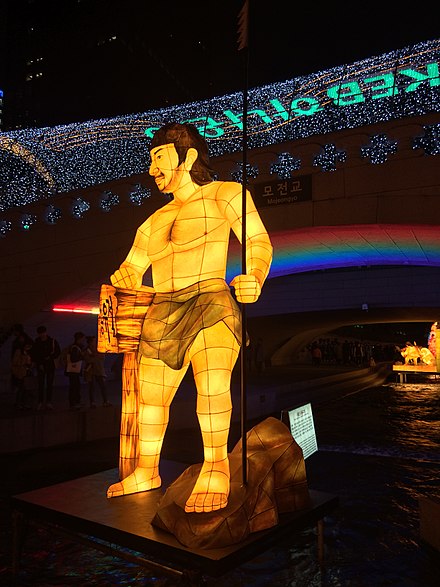

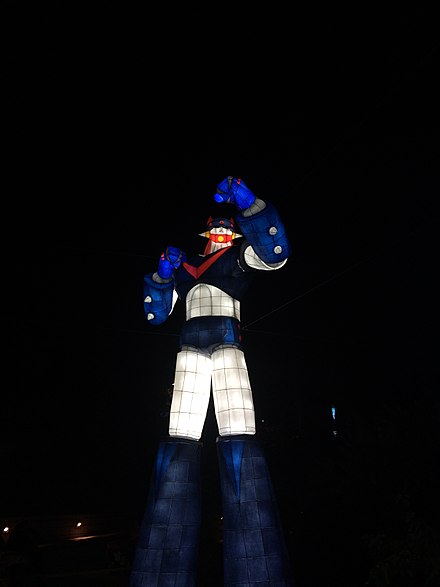

Buy
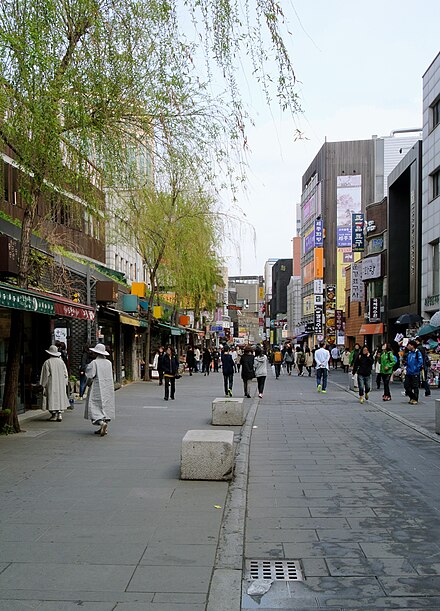
- Dongdaemun Market, 266, Jongno-6 ga, Jongno-gu, Seoul, 서울특별시 종로구 종로 266 (종로6가) (Seoul Subway Line 2, 4, 5 Dongdaemun Stadium Station, or Line 1 or 4 Dongdaemun Station), 37.571007°, 127.009886°. Though not as impressive architecturally as Namdaemun, the Dongdaemun market is infinitely more interesting than the its counterpart. 2018-02-17
- Gwangjang Market (광장시장), 88, Changgyeonggung-ro, Jongno-gu, Seoul (Line 1, Jongno 5-ga station), 37.570085°, 126.999330°, +82-2-2267-0291. Famous traditional market in Seoul. It was one of the first permanent market in Korea, and it is always crowded. It has a variety of silk, linen, and other traditional items. Street food is really excellent as well, especially bindaetteok(Mung Bean Pancakes). 2018-02-27
- Insadong, 37.571692°, 126.986243°. Insadong is an area known for its art galleries and shops, and is possibly the most touristy place in South Korea. It is a great place to buy cultural souvenirs. There are also a few stores that offer interesting vintage toys and various kitsch. Insadong also contains many traditional tea and coffee shops. It is one of the few places where vegetarian restaurants can be found.
- Ssamziegil, 37.574300°, 126.984800°, +82 2-736-0088. 10:00 to 20:30. Ssamziegil is a shopping complex located at the beginning of Insadong-gil that opened in 2004. It has the form of a rectangular spiral on three floors, and includes about a hundred craft shops (clothing, jewelry, leather, etc.), Restaurants, cafes (one of them, the Sky Garden is the terrace on the third floor). Very good place to shop green, costume jewelry, or just a drink. For some activities (candle making, pottery decoration, etc.), you have the option of making your own objects in the basement..
- The store from Tong-In, 37.574778°, 126.984081°, +82 2-732-4867. Occupying four floors, this store offers high quality items, including pottery, inlaid, lacquered objects, as well as jewelry, postcards, etc. Not necessarily cheap, but the quality is good. It is located a little further than Ssamziegil on the same side of Insadong-gil. 2019-10-16
- Kyobo Book Store (Kyobomungo, 교보문고/敎保文庫), Jongno1-ga, Jongno-gu (Gwanghwamun Station, Line 5, Exit 3), 37.5705°, 126.9777°, +82 2-397-3500. 09:30 to 22:00. Kyobo is the largest chain of bookstores in South Korea, and this store is located in the center of Seoul. It is completely invisible from the outside, because it is underground. It is accessed directly from the Gwanghwamun subway station, or at the intersection of Sejongno and Jongno. There is a huge selection of books, CDs, DVDs, stationery items, cardmaking, and a bunch of other accessories (there are even handbags). Also has books in foreign languages.
Eat
- Sadongmyenok (사동면옥), 29-21 Jongno Gwanhun (Insadong 8-gil, down the alley), 37.57388°, 126.98582°. Justly famous for its manduguk, a soup of gargantuan homemade dumplings stuffed with meat and veggies and served with side dishes for ₩5,000. English menu available.
- Gung, 37.574323°, 126.985441°, +82 2-733-9240. Specialty restaurant for mandu (Korean dumplings) from the nearby Kaesong region in North Korea. The chickpea patties are also very good. This restaurant has been passed down from mother to daughter for three generations.
- Everest (에베레스트레스토랑), 148-1, Changsin-dong, Jongno-gu (Dongdaemun stn, exit 3; walk straight for 100 m; turn left at the pharmacy and walk 50 m), 37.5724°, 127.0124°, +82 2-766-8850. 11:00-23:00. Nepali restaurant featuring dozens of delectable dishes ranging from mutton curry to butter naan. Bollywood music videos are free. ₩8,000-15,000
- Samcheong Sujaebi (삼청동 수제비), 37.58454°, 126.98202°. Canteen style ambiance, renowned for serving good Sujaebi - a mild soup where the noodles are flattened and torn into sheets. Always packed with people so be prepared for a queue. ₩8000-13,000
- Tosokchon, 5, Jahamun-ro 5-gil, Jongno-gu, 37.57775°, 126.97152°. Reverently referenced in most local guides as the place for Ginseng chicken soup and variations on that theme. ₩15000-25000 2015-05-19
Drink
- Bar Mou (모우), Jongno 1(il).2(i).3(sam).4(sa), Jongno-gu, 37.570696°, 126.988882°, +82 70-8946-6448. 19:00-04:00. 2015-10-11
- Miller Time (밀러타임 종로점), 11-13, Gwancheol-dong, Jongno-gu, 37.568857°, 126.985403°, +82 2-737-4466. 2015-10-11
Sleep
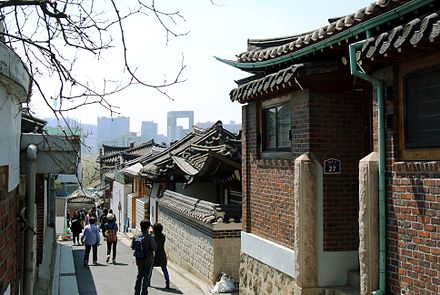
Budget
Jongo
- Banana Backpackers, 30-1 Iksun-Dong, Jongno-Gu (5 min from Line 3 Anguk Station), 37.575°, 126.989°, +82 2 3672-1973. English speaking staff, free Wi-Fi, free laundry, kitchen. Dorms from ₩20,000, private bath from ₩40,000
- Bong House, 117-2 MyeongRyun3Ga MyeongRyunDong JongroGu, 37.584°, 126.997°, +82 2 6080-3346. Check-in: 14:00, check-out: 11:00. Laid-back friendly guesthouse with Internet, Wi-Fi, purifier, washing machine, air-con, refrigerator, cable TV, gas oven, microwave oven, hair dryer, iron with ironing board and dryer for a fee of ₩5,000. The Bong bar which is right next to the Bong house. With each night stay you can claim 1 free beer from the bar. ₩12,000-105,000
- Hostel Korea, 178-65 Sungin-dong, Jongno-gu (4 min from Line 1 Sinseoldong stn exit 11), 37.575°, 127.020°, +82 2 762-7406, +82 2 766-7406. Friendly English/Chinese-speaking staff. Free breakfast, free Wi-Fi, free laundry, air-con, hot water. ₩25,000, en suite bath from ₩30,000
- Seoul Guest House, 135-1 Gyedong, Jongno-gu (Metro Line 3, Anguk Station), 37.58026°, 126.98739°, +82 2 745-0057. Basic rooms with air-con in a traditional Korean-style house. Shared bathrooms, free Wi-Fi, and TV. For a higher price you can purchase a room with a private bath, television and computer with Internet. Some find it spartan, other like its homey feel, friendly owner and big, fluffy guard dog. From ₩35,000
- Songwontel Hostel, +82 2-765-7224. 102-62 Doneui-dong, Jongro-gu, (Metro Line 5, ChongRo Sam Ga, exit 2 in a small backstreet). Free Wi-Fi. Clean, comfy yet small rooms with private bathroom, AC and TV. The receptionist speaks some English. Double rooms ₩38,000/night on week days, ₩45,000/night on weekends. 2012-02
- Wind Road & Flower Guesthouse, 1F 85-5, Myeongryun-dong 3-ga, Jongno-gu, ~3. 1F 85-5, Myeongryun-dong 3-ga, Jongno-gu, ~3, +82 2 6407-2012, cowindrea@paran.com. Free internet, laundry also available (but not free). The friendly staff speaks good English. Dorm: ₩17,000-19,000
- Yim's House, 33 Waryong-dong, Jongno-gu (Metro Line 3, Anguk Station), +82 2 747-3332. This excellent value hotel is unsure whether it caters to businessmen or backpackers. Rooms are clean and spacious, and Mr. Yim speaks fluent English. En suite singles ₩30,000, doubles ₩38,000
Hyehwa-dong
- Bangrang Hostel, 397-12 Chungnim-Dong, Chung ku (Metro Line 2, Chungjeongro Station, exit 5), +82 2 6614-2246. Check-in: 14:00, check-out: 11:30. Distinguished interior. 1 min from subway station, 2 min from airport bus stop. ₩18,000+
- Golden Pond Guesthouse, 188-16, Myeongryun1ga-dong (Metro Line 4, Hyehwa Station, exit #4, 5-minute walk. Airport bus, Sung Kyun Kwan Univ. stop, 3-min walk), +82 2 741-5621, +82 10 9921-5621 (cell). Comfortable, young atmosphere, with decent bathrooms and a friendly owner and staff. Two computers available for free Internet use, Wi-Fi throughout. This place is near a lot of pubs and restaurants, but very quiet when you sleep. No curfew. All staff is ready to hang out with guests every night. Sometimes they serve Korean meals for free. Kitchen, free laundry. Dorm: ₩20,000, single: ₩60,000, double: ₩75,000
Mid-range
- Ramada Seoul Jongno, 48-26 Inui-Dong, 37.57°, 126.99°, +82 2-2174-6500. 2015-05-04
Splurge
- JW Marriott Dongdaemun Square Seoul, 279, Cheonggyecheon-ro Jongno-gu Jongno 6(yuk)-ga (on top of Dongdaemun metro station), 37.57°, 127.01°, +82 2-2276-3000. 2015-05-04
- Chiwoonjung (취운정), 41 Bookchon-ro, 11ga-gil, Jongno-gu, 37.58°, 126.98°, +82 2-765-7400. Luxury traditional Korean-style guest house. 2015-05-04
Connect
As with anywhere else in Seoul, there are plenty of PC rooms ('PC Bang') available to go online for a few hours on a good machine for only a few thousand won.
Jongno District
jongno.go.krSeoul
Primary administrative division
_(42).JPG/440px-Gyeongbok-gung(place)_(42).JPG)